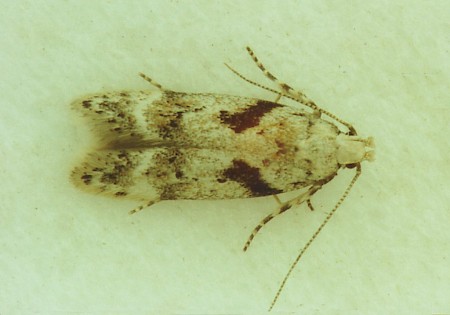35.133 BF832
Caryocolum blandella
(Douglas, 1852)
Wingspan 9.5 mm- 14.5 mm.
A fairly distinctive moth, although it can resemble some other Caryocolum species; it can usually be separated by its white head and solid dark band on the forewing. Specimens under 11 mm wingspan might be confused with the similarly marked C. blandulella, which appears to be restricted to sand dunes in Kent and Hampshire. Doubtful specimens should have their genitalia examined with the aid of MBGBI Vol.4-2.
Locally distributed in England and Wales, it generally occupies hedgerows and woodland habitat.
The moths fly in July and August. The larva feeds on greater stitchwort (Stellaria holostea), at first in a mine, then in spun shoots or seed capsules.
Larva: (description Ian F. Smith)
Foodplant: Stellaria holostea. April - early June. Initially in a gallery mine by the midrib. Later in lightly spun young growth which it wrinkles and whitens. Often inside a seed capsule which it turns slate grey.
Length: Final instar, 7 mm, described.
Head: Black.
Prothorax (T1): Conspicuously distinct from T2 and T3. Integument translucent rosy brown. Large dark red-brown prespiracular and subventral pinacula.
Prothoracic shield black, divided by a thin yellow medial line which is widest at posterior.
Mesothorax (T2): Coloured as abdomen.
Metathorax (T3): Coloured as abdomen.
Thoracic legs: Those on T1, pitchy brown, markedly darker than yellow legs on T2 and T3.
Body: Yellow (MBGBI; yellowish green). Finely shagreened. Slightly paler ventrally.
Spiracles: Small. Peritreme brown.
Pinacula: Very small, consisting of a fine black setal spot with a very narrow grey sclerotised periphery.
Setae: Transparent, fine, blackish basally.
Anal plate: Coloured as abdomen, but slightly more shiny.
Prolegs: Translucent, coloured as abdomen. Crochets reddish brown.
Pupa: June - July. In a whitish cocoon among debris. The brown pupa shows white and black of the developing imago about five days before emergence.
Similar species: The distinct appearance of segment T1 is not mentioned in MBGBI, nor shown on the illustration in Stainton. The larva described above was not seen at earlier instars, so it may be only a feature of the final instar. However, MBGBI and Stainton indicate that a dark segment T1 is common to several species of Caryocolum, so it can not be used to distinguish C. blandella.
Other Caryocolum species which feed on Stellaria holostea are:
C. tricolorella, Dec.- April, pink dorsal, subdorsal and lateral lines.
C. kroesmanniella Oct. - May. Light green. T1 legs black.
C. huebneri May. Larva undescribed. S.E. England. Extinct in Britain?

 UKMoths
UKMoths 





